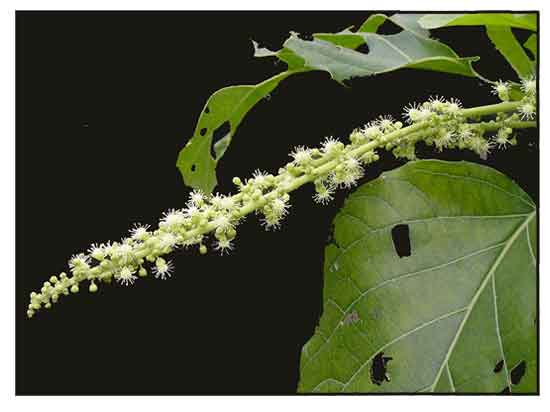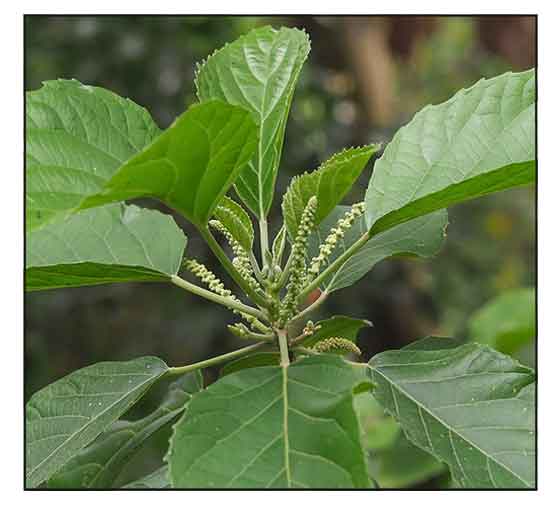
Family • Euphorbiaceae
Common claoxylon
Claoxylon indicum (Reinw. ex Blume) Hassk.
NAPPY TREE
Bai tong shu
| Scientific names | Common names |
| Claoxylon caerulescens angustifolia Ridl. | Claoxylon (Engl.) |
| Claoxylon indicum (Reinw. ex Blume) Hassk. | Common claoxylon (Engl.) |
| Claoxylon indicum var. genuinum Müll.Arg. | Indian claoxylon (Engl.) |
| Claoxylon indicum f. gracilius J.J.Sm. | India whitetung (Engl.) |
| Claoxylon indicum var. macrophyllum (Hassk.) Müll.Arg. | Nappy tree (Engl.) |
| Claoxylon indicum var. spathulatum Müll.Arg. | |
| Claoxylon macrophyllum Hassk. | |
| Claoxylon macrophyllum Bojer | |
| Claoxylon minus (Blume) Hassk. | |
| Claoxylon molle (Blume) Miq. | |
| Claoxylon parviflorum Hook. & Arn. | |
| Claoxylon polot Merr | |
| Croton halecum Roxb. | |
| Croton halecum Roxb. | |
| Croton pigmentarius Noronha | |
| Croton tabacifolius Geiseler | |
| Erythrochilus minor Blume | |
| Erythrochilus mollis Blume | |
| Erythrochilus multiflorus Zipp. ex Span. | |
| Niota globosa minor Blume | |
| Claoxylon indicum is an accepted species. KEW: Plants of the World Online | |
| Other vernacular names |
| CHINESE: Bai tong shu, Diu le bang. |
| MALAYSIA: Laping budak, Jarak kayu, Lampin budak. |
| ANDAMAN & NICOBAR ISLANDS: Hin nguoyo, Amah, Singenro. |
| VIETNAMESE: Hoc kheo, Loc mai. |
Gen info
Distribution Constituents Properties Studies Availability |
May 2025
![]()
 |
| Â Â Â Â Â Â Â Â Â Â Â Â Â Â Â Â Â Â Â Â Â Â Â Â Â PHOTOS / ILLUSTRATIONS |
| IMAGE SOURCE: Claoxylon indicum / 阿橋 HQ - 白æ¡æ¨¹Â / CC BY-SA 2.0 / Click on image or link to go to source page / Wikipedia |
| OTHER IMAGE SOURCE: Laping budak -Claoxylon indicum /  © Maple / Non-commercial use / Click on image or link to go to source page / PictureThis |
Additional
Sources and Suggested Readings |
• |
DOI: It is not uncommon for links on studies/sources to change. Copying and pasting the information on the search window or using the DOI (if available) will often redirect to the new link page. (Citing and Using a (DOI) Digital Object Identifier) |
| Â Â Â Â Â Â Â Â Â Â Â Â Â Â Â Â Â Â Â Â Â Â Â Â Â Â Â Â Â Â List of Understudied Philippine Medicinal Plants |
| Â Â Â Â Â Â Â Â Â Â Â Â Â Â Â Â Â Â Â Â Â New plant names needed The compilation now numbers over 1,500 medicinal plants. While I believe there are hundreds more that can be added to the collection, they are becoming more difficult to find. If you have a plant to suggest for inclusion, native or introduced, please email the info: scientific name (most helpful), local plant name (if known), any known folkloric medicinal use, and, if possible, a photo. Your help will be greatly appreciated. |
• |
 |



